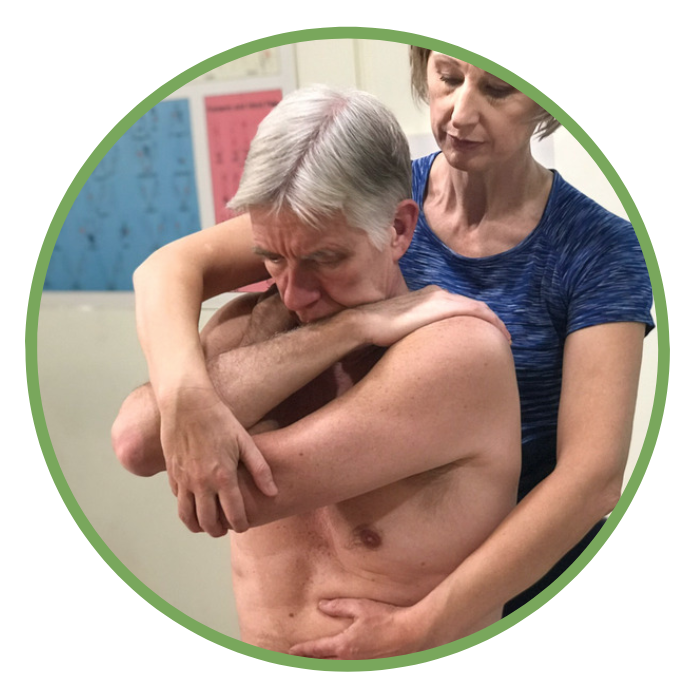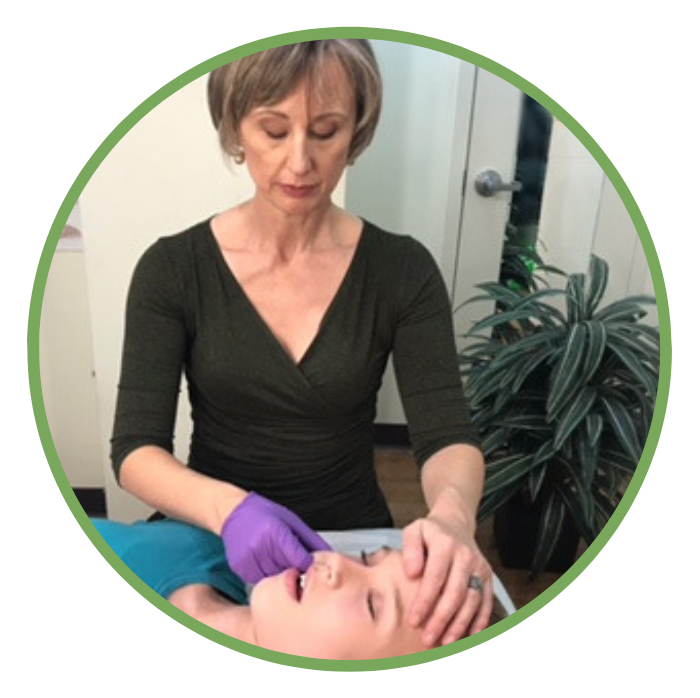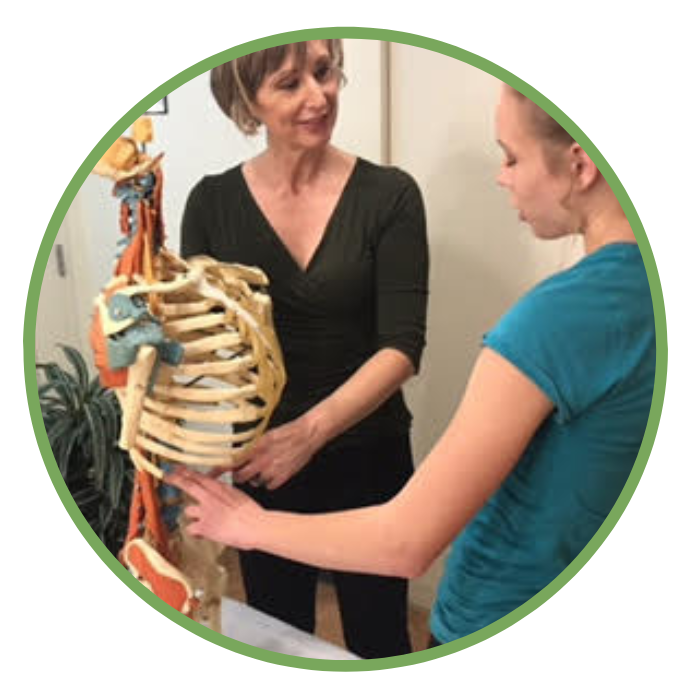


Manual Therapy
Manual therapy is a hands-on approach to assess and treat neuro-muscular, visceral, neurological and women’s health dysfunction. The goal is to identify and alleviate restrictions and compensations that have settled in the body over time due to factors including lifestyle, habits, physical trauma, and surgery. Manual therapy normalizes the mechanics and physiology of the body’s different systems and it promotes better working interrelationships among them. The results are joints that move more freely with increased range of motion, muscles and internal organs that are freed from restrictions, nerves released from impingement and a body that works more efficiently and painlessly. Michèle often combines manual therapy with acupuncture and functional rehabilitation to optimize the healing process and reduce the chance of relapse.
Manual therapy requires a true commitment from the therapist to know the body thoroughly and to obtain mastery of therapeutic skills. Michèle brings to each treatment session her knowledge of cutting-edge manual therapy techniques and her passion for the body and anatomy.
Myofascial Release
Myofascial release is a gentle process of stretching, lengthening, and freeing the fascia from restriction. The fascia is the dense, tough tissue that surrounds and interconnects the body’s organs, muscles, and bones. Fascia can lose its pliability and become tight as a result of disease, overuse, trauma, infectious agents or inactivity, creating tension in parts of the body with resulting pain and restriction of motion. After an area of tightness is identified, a gentle stretch is applied until the tissue begins to relax. The process is repeated and the stretch is gradually increased until the area is fully released from restriction. Progress can be measured by a decrease in the patient’s pain and by improved range of motion and overall posture.
Trigger Point Dry Needling
A myofascial trigger point is the small, hard nodule “knot” in the muscle tissue that is tender to touch and may be felt in the middle of the tight muscle band. Trigger points can cause symptoms that may be quite distant from the actual painful area (referred pain). Dry needling involves the insertion of acupuncture needles into the trigger points to release the “knot,” relieve the pain, and increase the range of motion. Michèle incorporates trigger point dry needling as part of a complete therapy program combined with manual soft tissue release, stretching, and neuromuscular reeducation.
Visceral Manipulation
Visceral manipulation is a gentle and precise osteopathic manual therapy technique that facilitates the body’s natural ability to release restrictions, compensations, and pain caused by visceral dysfunction. The visceral system refers to internal organs or “viscera.” Its optimal health depends upon each organ’s inherent physiological, rhythmical movement, and connection to the musculoskeletal system through fascia and ligaments. If an organ loses mobility due to physical trauma, surgery, lifestyle, infection, pollution, diet, or other factors, its natural physiological movement is altered. When an organ’s movement is restricted, it brings stress by pulling on the musculoskeletal system via its fascial connection. The body is forced to compensate, creating abnormal points of tension that result in chronic irritation, functional and structural problems, and pain. Through soft manual pressure, visceral manipulation reestablishes normal mobility, tone, and motion of the viscera, as well as normalizes its connection with the musculoskeletal system.
Craniosacral Therapy
The craniosacral system consists of the dura mater membrane and the cerebrospinal fluid that surround and protect the brain and spinal cord. It extends from the bones of the skull, or cranium, to the sacrum or tailbone area. When bones or tissues are restricted and cannot move properly, the flow of the cerebral spinal fluid is restricted. The result is an imbalance that can cause sensory, motor, or neurological dysfunctions in the entire body.
Craniosacral therapy is a subtle, light-touch, hands-on manipulation of the connective tissue and bone structures that releases restrictions and obstructions in the craniosacral system and relaxes the nervous system. It rebalances the body at a deep and subtle level, allowing for improved functionality and a reduction in pain.
Neural Manipulation
A nerve functions optimally when it is able to move freely within the surrounding tissue. If it becomes fixed, it loses ability to glide and/or stretch in length. With fixation, smaller nerve sections can harden and become sensitive or painful to the touch. Neural manipulation identifies and releases nerve restrictions while at the same time addressing the effect these restrictions may have on the rest of the body. Neural manipulation can resolve more comprehensive dysfunctional patterns by helping to release nerve fixations. It also can facilitate nerve conductivity and intraneural blood supplies, both locally and systemically. Neural manipulation is administered through precise and gentle applied pressure.
Pain Management
Chronic pain can have a devastating effect on a person’s quality of life. It can limit your ability to work and perform daily tasks, partake in social activities, and interact with others. Pain infringes on your range of activity by directly affecting physical abilities, but also affects mood, sleep, memory, the immune system, and metabolism. Most patients opt for pain medication, but are often unaware of other alternative, complementary options. Research has demonstrated that the most successful pain management plans combine a number of strategies, where the use of medication is often subordinate.
Michèle Masset successful strategy to overcome pain involves: understanding and treating the root cause of the pain, braking the pain cycle, restoring movement and function, alleviating the stress caused by pain by relaxing both the central and autonomic nervous system as well as educating the patient about self-pain management tools and how to prevent the reoccurrence of pain. Her multi-dimensional approach, the diversity of knowledge and skill that Michèle brings to each treatment gives her patients a greater potential to successfully overcome their pain and return to a normal life.
Posturology
Posturology is the science of studying the postural system’s sensors that are responsible for informing the central nervous system about any imbalances in our body. Neuroscience has identified sensors throughout the body (the feet, the eyes, the inner ear, the skin and the jaw) that send signals to the brain and are responsible for the way the brain organizes our posture (muscle tone and alignment of the skeleton). Any problem in one or more of these sensors will send a faulty sensory input to the brain, which in return will send a signal to the body to adjust to the faulty signals, and create a pathological imbalance in the body. The aim of posturology is to correct errors of the sensor sites and return the body to proper equilibrium. Posturology is widely used in Europe to treat chronic pain, but is also used by high-level athletes to maximize their performance.
Graston Technique
The Graston Technique® is a therapy that utilizes instruments to move and stimulate soft tissue for treatment of adhesions, restrictions, scar tissue, and other fascial dysfunctions—also known as “instrument assisted soft tissue mobilization” or ISTM. This advanced technique is a patented therapy that utilizes contoured steel instruments for detection, isolation, and mobilization of lesions in the tissue. The treatment can be effectively used to assist patients with pain relief, mobility, and increased balance.
Physical Therapy for Breast Cancer
The diagnosis and treatment of breast cancer can be both physically and emotionally overwhelming. In the healing journey it is important to surround yourself with competent and caring practitioners. After a lumpectomy, mastectomy, breast reconstruction, radiation, and/or chemotherapy, the body needs to recover physically, neurologically, physiologically, and emotionally. An integrative approach offers more than improved motion and function of the affected body parts—the usual goals of conventional physical therapy. A holistic focus helps to alleviate stress, rebalances your body both physically and emotionally, optimizes your recovery, and restores self-confidence. Michèle offers a unique set of skills and knowledge that she tailors for each breast cancer patient before, during, and after treatment.
Common Conditions treated by Manual Therapy
Orthopedic
- Chronic and acute neck and back pain
- Degenerative disc disease
- Spinal dysfunction
- Lower back pain sciatica
- Shoulder upper extremity pain
- Frozen shoulder
- Hip, knee, ankle and foot pain
- Arthritis (osteo- and rheumatoid)
- Tendonitis, bursitis
- Postural dysfunction
- Post-surgical pain
- Temporomandibular (TMJ) dysfunction
Neuromuscular
- Myofascial pain syndrome
- Repetitive stress injury
- Carpal tunnel syndrome
- Headache, migraine
- Post-surgery scar tissue release
- Neural tension and pain
- Fibromyalgia
- Complex regional pain syndrome (CRPS)
- Concussion
- Neuralgia
- Nerve entrapment
Visceral
- Post-operative abdominal and thoracic scar tissue pain
- Digestive disorder
- Acid reflux
- Women’s and men’s pelvic pain
Women’s health
- Post-mastectomy and lumpectomy pain and dysfunction
- Pregnancy-related conditions
- Pelvic floor pain
- Diastase rectus
- Post surgical adhesion
